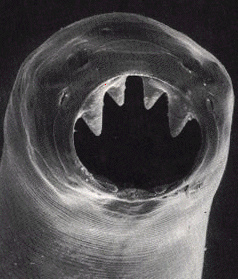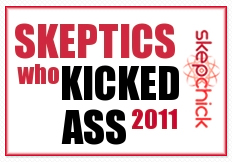Today was another interesting day at the International Proteolysis Society meeting.
We had talks about scabies in the Aboriginal population, the mites that spread the disease, and I interviewed Dr Alex Loukas, parasitologist from the Queensland Institute for Medical Research. Dr Loukas has an interest in a member of the Helminth family the hookworm, and is currently working on developing a vaccine against the infection.
Hookworms are no longer a big problem for humans in Australia, but remain a health risk in the developing world. The manifestation of a serious hookworm infection is anaemia from a loss of blood, corresponding with low levels of iron.
Like the malaria parasite I wrote about in my previous post, hookworms consume the haemoglobin component of blood and they do this by latching onto the walls of the intestine and leeching blood into their gut. They then excrete the left overs out through their anus.
Which brings me to the pornography part of Alex’s talk yesterday. He has a video taken during a routine colonoscopy (which failed to work during the presentation and I can’t say that I am really sorry) showing a dog hookworm attached to the inside of a human patient’s intestine. According to Alex, it precisely demonstrates this process.
He refers to it as “pornography for parasitologists”. And people say scientists are weird.
But seriously, the main focus of Alex’s work is to develop a vaccine for hookworm. This might sound a bit strange to you at first, since many of us would know that there is already one available for dogs. Alex told me however that this vaccine, whilst a viable technology to adapt for human use, is far too expensive to use in the developing world. This is because it is an “attenuated vaccine”, meaning the hookworm larvae are irradiated to a senescent or no longer active state, then when the immune system is exposed to them, antibodies are created and immunity developed. This is a very expensive process however, requiring the culturing of hundreds of thousands of hookworm larvae for vaccine manufacture. Cost is a critical factor for the availability and distribution of medical care in the developing world.
To overcome these issues, Alex’s approach is to create an antibody against a protein in the feed cycle of the hookworm. This enzyme is critical for the final stages of the digestion of the haemaoglobin component of the blood. If the enzyme doesn’t work, the hookworm cannot extract nutrients and it effectively starves to death.
The method of delivery of the antibody to the gut of the worm is particularly fascinating. The host, being the human, is exposed to the hookworm gut protein, thereby making antibodies against it, which will enter their blood stream. The hookworm then feeds on the blood, ingests the antibodies which enter its gut and stop the digestive enzymes from working. Alex refers to this as the “Poison Chalice” of vaccines. Elegant and ingenious.
To hear the full interview with Alex Loukas, tune into the Skeptic Zone , episode 56, on November 13, 2009. Find us on iTunes.
See an alternative image of a hookworm eating its prey here.







